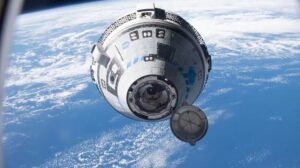 Boeing has pushed back a crewed flight on the Starliner spacecraft to April 2023. Boeing said the launch is now scheduled for April due to “scheduling needs” of the International Space Station. NASA agrees the new launch timeframe is optimal for the International Space Station visiting vehicle schedule.
Boeing has pushed back a crewed flight on the Starliner spacecraft to April 2023. Boeing said the launch is now scheduled for April due to “scheduling needs” of the International Space Station. NASA agrees the new launch timeframe is optimal for the International Space Station visiting vehicle schedule.
“We understand our customer must consider the needs of the International Space Station in scheduling the certification flight of a second U.S. commercial crew transportation system,” said Mark Nappi, vice president and program manager for the Starliner program. “We are working to have the CFT vehicle ready to fly ahead of the new launch date.”
 The refurbishment of a previously flown crew module and production of a new service module for CFT are continuing at Boeing’s Commercial Crew and Cargo Processing Facility in Florida. Once both modules are complete, they’ll be mated and tested for flight.
The refurbishment of a previously flown crew module and production of a new service module for CFT are continuing at Boeing’s Commercial Crew and Cargo Processing Facility in Florida. Once both modules are complete, they’ll be mated and tested for flight.
The Starliner team recently completed a successful Crew Validation Test (CVT) with NASA astronauts Butch Wilmore, Suni Williams and Mike Fincke. CVT is a critical milestone conducted near completion of the crew module and is a measure of confidence for the astronauts as they progress toward launch.
Boeing and NASA are working together to achieve flight readiness. In-flight anomalies from Starliner’s Orbital Flight Test-2 (OFT-2) are on a path to close in the coming weeks, following thorough data reviews, fault tree analyses, and agreed-to mitigation plans.
The mission will launch from Cape Canaveral Space Force Station in Central Florida. An uncrewed capsule launched from Cape Canaveral Space Force Station and Boeing’s Starliner was aboard a United Launch Alliance Atlas V rocket.
“Starliner’s two uncrewed orbital flight tests provided invaluable information about our spacecraft,” Nappi said. “Additional learnings are expected as Starliner transitions from a fully autonomous flight without crew to flights with crew. With the help of experienced NASA test pilots, Wilmore and Williams, we are closer to our goal of flying a safe and capable spacecraft.”


